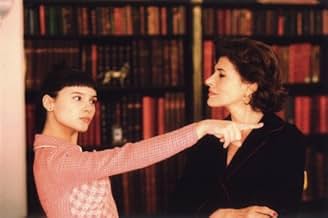'8 Women' is a rather unique film. On the surface it is the probably only entry in the genre of the grotesque whodunit-musical. But actually, it's a huge playground - for the actresses who get the chance to play with the stereotypes attached to them, and for director François Ozon to toy with the clichés of the whodunit.
Here's the setup: 1950s. A beautiful mansion. A man is found lying in his bed with a knife in his back. The possible suspects: His wife, his two daughters, his sister, his mother-in-law, his sister-in-law, the chambermaid and the cook. As these eight women can't leave the estate or call the police, they try to find the murderer themselves. We know this situation from countless Agatha Christie-stories.
But what Ozon makes of this situation is just incredible. It already begins with the casting: Who else could play the gentrified Gaby if not Catherine Deneuve? Is there any actress who would fit more perfectly for the role of the spinsterish sister than Isabelle Huppert? Who else would you want to walk around in that dress of a chambermaid than the most desirable Emmanuelle Béart? The actresses are eagerly playing with the stereotypes that surround them because of both, the roles they played and their private lives.
Then there's the story: All whodunits have those obligatory scenes where the motives of all characters are revealed. '8 Women' takes that formula and deliberately goes over the top with it, it's characters are unfaithful, pregnant, lesbian, poisoners and many things more. And as a final twist, the film stops eight times to give each of its protagonists a chance to reveal her true character in a scene entirely devoted to them - singing and dancing. There is also another scene worth mentioning that is entirely dedicated to the actresses: A scene with a lot of dialog that entirely consists of nothing but a series of closeups - and that for about three minutes.
Cinephiles can enjoy this film on even another level: The film is filled with references to beloved classics. Consider Fanny Ardant's musical number, which pays homage to Rita Hayworth's glove-strip in 'Gilda', and another Rita Hayworth-moment so wonderful I won't reveal it here. Consider Emmanuelle Béarts hairstyle that echoes Kim Novak in 'Vertigo'. Consider the fact that the late husband of the Dannielle Darrieux character was a general, reminding us of 'Madame de...'. Or consider the painting of the young Catherine Deneuve hanging in one room - a replica of a 'Belle de jour'-poster. All this is supported by the rich, colorful cinematography, the art direction and the costumes, that give the entire film a 1950s look.
But attention: If you give this film a chance, don't expect it to be logically consistent. It isn't. But that doesn't matter at all. The murder mystery story is replaceable. The film is entirely devoted to its brilliant actresses and the wonderful, bitchy dialog they exchange. It's great fun and it is getting better with every viewing.

![Regarder Bande-annonce [OV]](https://m.media-amazon.com/images/M/MV5BZWE0NDNkYWMtZWEyMi00NjVjLTg2N2ItNzg3ZDcwNzYzNmQ0XkEyXkFqcGdeQXRyYW5zY29kZS13b3JrZmxvdw@@._V1_QL75_UX500_CR0)



























